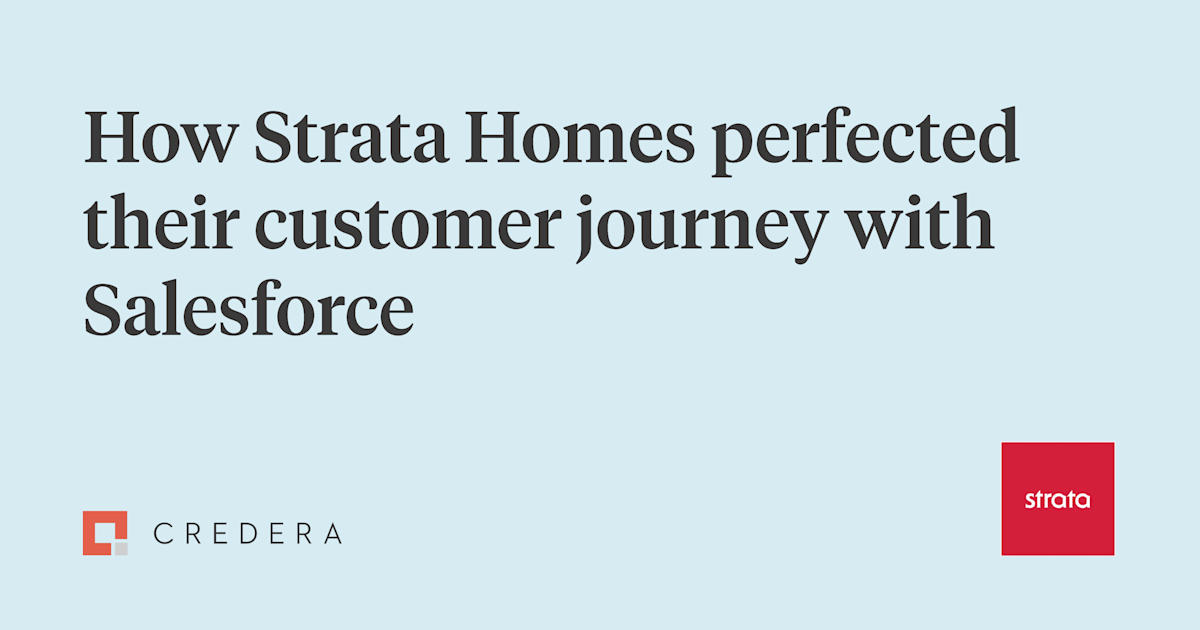Transformation
Feb 15, 2021
How Strata Homes perfected their customer journey with Salesforce

In 2021, we joined Unissu’s RE:Connect event, joining 400 other speakers on the future of the built environment. We invited our customers from Strata Homes, Anjudeep Badachha, Head of Business Improvement and Matt Bloomer, Head of Customer Journey. We asked them how they’d turned around CRM at Strata, and how they optimised their customer journey using Salesforce.
This blog outlines some of the highlights of the conversation. You can access the full webinar replay here.
We’ve come a long way: starting out with Salesforce
Strata Homes describes itself as “not your average house builder”. The company prides itself on its customer experience, promoting that it builds homes rather than just houses. To live up to the company’s promise requires personalised and responsive communication with customers. Anjudeep (Anj) looked back to 2014 when they were just starting out with Salesforce: “Everything was offline and it was a shift to get people from having things tangible in their hands to then having everything digital. We were very much paper-driven.”

Matt agreed with the point, further describing how long it would take to get the detail about a customer’s issue. The “antiquated process” was slow, which resulted in unsatisfied customers. “At that point we realised we needed a new way of working for the future.”
The first hurdle: culture
The first step for Strata was embedding a culture and a mindset. They had to work with the organisation and individual teams to sell the benefits of optimising the customer journey with Salesforce. Once they start to understand it, they can start to shape it to suit them. They take ownership of it.
Anj used the example of some departments that were unable to engage in the changes the implementation team proposed – or even, were unwilling. But there were other departments that were more process-driven. They understood the set sequential logic that each process has. Getting them on board meant that they started to become champions for Salesforce and helped to shape it for other teams.
Like many companies, Strata had a mix of people to get on board. There were “people who have been part of the furniture for 30 years”, as well as others who had used Salesforce before. They were useful for giving advice on the best ways to work within the teams.
Strata also engaged the wider supply partners, subcontractors and supply chain to show them the benefits. When they launched Salesforce, they asked them to join the journey. That helped to change their culture and embedded the change within the business.
Hallmarks of success
Like many housebuilders, Strata is a company that needs to respond quickly to its environment. They have a culture of getting work done quickly and efficiently. By improving the customer journey with Salesforce, they wanted to become more proactive. Anj and Matt talked about how they collaborate, slowing down the process of manipulating Salesforce to suit a department’s needs. Their Salesforce journey has helped them balance proactive and reactive work. It has enabled them to more frequently consider “the bigger picture”, and put in a process behind their success.
Salesforce has become that hub of central information when it comes to anything that the business needs regarding a customer.
Anjudeep Badachha, Head of Business Improvement
If anyone has a question about any customers, regardless of their journey, Salesforce is now the place to go. It informs their business decisions and it’s also a place to help manage change.
Matt thought back to their office refurb, when they had to go through hundreds of paper files – and at one point, a mouse ran out! At that point they said to each other, “We can’t work in this way again”. This was a turning point, where the mindset really did begin to shift with the business. They recognised the amount of information they had and what it could offer their core value of the customer journey.
Their supply partners are part of their success. They have their own community portal where Strata can manage cases and communicate with them. Having that set up already was especially helpful during the pandemic.
Pandemic-accelerated change
Matt referred to a specific example around how Salesforce had helped them during the pandemic. They had to make a moral decision that during lockdown, they would only tend to emergencies and some external works. That meant certain cases that were booked in needed to be reviewed immediately. The team communicated to customers, managed the cases, got them on hold, and communicated to the wider supply chain.
Strata needed to send out a consistent message about their position in the business to avoid any confusion.
Would we have been able to do this two or three years ago? Absolutely no chance!
Matt Bloomer, Head of Customer Journey
Their digital advancement has made them realise that, as they’ve progressed, they want to work with like-minded companies. So when they are tendering for jobs, they ask about the technology they use and their openness to change.
When they have relationships with organisations for years who have been loyal to them, they want to bring them along and help them develop too. They show them the benefits of the system and slowly others are starting to engage. Times have changed and work needs to be managed differently. Everyone needs to adapt and anticipate their next steps in their CRM journey.
The next step: systems integration
The current environment has escalated digital transformation. Everything has changed in regards to the way we work and the way we live. We’re spending a lot more time in front of our devices. This sped up the journey for many companies as well as Strata. Their next step is focusing more on systems integrations.
Salesforce is the core system that Strata has for everything to do with their customers. But they have other systems that they need to integrate. This will give them more meaningful information and “let the systems do the hard work”.
When it comes to personalising the customer journey, Matt and Anj discussed how they had “just scratched the surface” with Salesforce. Personalisation is core to their business. Their marketing team has been working closely with Credera to integrate and automate the customer journey.
They use another tool for quality inspections, which they want to integrate into Salesforce to keep their data in one place. With this integration, Salesforce will allow them to quickly target sites, plots house types and root causes. Then they can feed that into the front-end of the design and build a better product.
“Technology is more than just a standalone system. It’s the value that it adds to the business.”
Technology frees up time for Strata’s employees to have a personal relationship with the customer. Some of their customers are only just starting out on this digitalisation journey now, so need guidance.
Strata’s advice on a CRM journey
“My advice would be to start simple and to start with teams that would have the most benefit from the CRM system.”
Do you start with your customer facing teams and ensure that you then take your team on that journey with you? It’s not something the IT department does in isolation. It’s something that is for the wider business. So that’s one thing Anj and Matt reinforced: once you do start small, remember that’s just the foundations.
Strata has been on the journey for years, and they will never “sit back and say, job’s done now”. Salesforce customer requirements and the digital industry is constantly evolving. They have a responsibility to keep up with customer needs and wants as well.
It’s also important to partner up with the likes of Credera. You need a partner who can guide you through the right steps and help with extensive testing. Process is crucial to get right before getting started. Everyone needs to work in the same way and keep data tidy, especially with experimentation along the way.
Build a structured timetable in place of what actions will be taken at what time. Manage upwards – and tell managers or leaders what you’re working on and what to expect. There will be a lot of changes to mindset and culture. People will want different things, not maybe understanding the technology fully. Once you, as the implementer, have a good understanding of what you want to achieve, start at the end and work backwards to build the system how you want it.
Choosing the right partner for your Salesforce journey
The most important reason Strata gave for choosing Credera as a partner was the close relationship with Salesforce. By having a conversation with a Salesforce account executive, Strata could be sure that Salesforce would relay information to Credera, ensuring everyone was looped in.
In addition, Strata highly values Credera’s specialist skills in certain areas. Every company should be able to consult an expert before mapping out their customer journey with Salesforce. Partners should challenge their customers to justify their thinking and suggest alternative solutions to choose from where relevant. Credera draws from experience with other customers who have been through similar situations when recommending solutions to apply.
“Not only do you shape and define the vision for us, you then help us execute it effectively.”
Watch the webinar below to hear the full detail of the interview with Strata Homes.
Contact Us
Ready to achieve your vision? We're here to help.
We'd love to start a conversation. Fill out the form and we'll connect you with the right person.
Searching for a new career?
View job openings